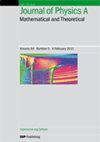有限维希尔伯特空间量子系统的框架表示法
IF 2.1
3区 物理与天体物理
Q2 PHYSICS, MATHEMATICAL
Journal of Physics A: Mathematical and Theoretical
Pub Date : 2024-09-09
DOI:10.1088/1751-8121/ad74bd
引用次数: 0
摘要
有许多人试图为具有有限维希尔伯特空间的量子系统定义维格纳函数,每种方法都有其优势和局限性。现有的有限版本定义简单,但它们只是基于与连续变量维格纳函数的形式类比,无法进行直观的状态分析。连续版本的定义更为复杂,但它们更接近原始维格纳函数,并允许对量子态进行可视化分析。我们提出的基于紧帧概念的版本是有限的,但它的某些特性和应用与连续版本类似。它允许我们以新的图形表示量子比特状态,并定义与之相关的新参数。框架表示法的一个重要优势来自冗余信息的使用。维格纳函数框架版本的取值并不是独立的。它们必须满足大量数学关系,这些关系在错误检测和纠正中非常有用。本文章由计算机程序翻译,如有差异,请以英文原文为准。
Frame representation of quantum systems with finite-dimensional Hilbert space
There exist many attempts to define a Wigner function for quantum systems with finite-dimensional Hilbert space, each of them coming with its advantages and limitations. The existing finite versions have simple definitions, but they are based only on the existence of a formal analogy with the continuous-variable Wigner function and do not allow an intuitive state analysis. The continuous versions have more complicated definitions, but they are closer to the original Wigner function and allow a visualization of the quantum states. The version based on the concept of tight frame we present is finite, but it has certain properties and applications similar to those of continuous versions. It allows us to present a new graphical representation of qubit states, and to define new parameters concerning them. An important advantage of frame representation follows from the use of redundant information. The values taken by the frame version of Wigner function are not independent. They have to satisfy a large number of mathematical relations, useful in error detection and correction.
求助全文
通过发布文献求助,成功后即可免费获取论文全文。
去求助
来源期刊
CiteScore
4.10
自引率
14.30%
发文量
542
审稿时长
1.9 months
期刊介绍:
Publishing 50 issues a year, Journal of Physics A: Mathematical and Theoretical is a major journal of theoretical physics reporting research on the mathematical structures that describe fundamental processes of the physical world and on the analytical, computational and numerical methods for exploring these structures.

 求助内容:
求助内容: 应助结果提醒方式:
应助结果提醒方式:


